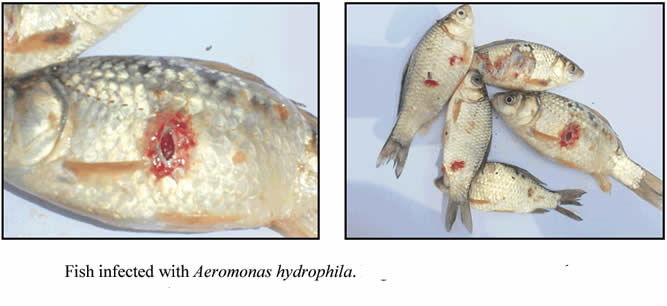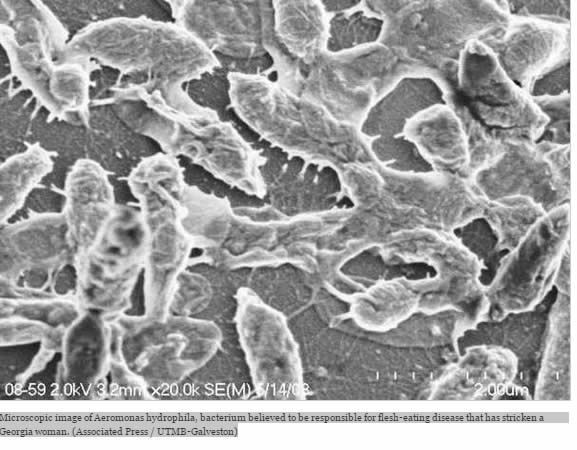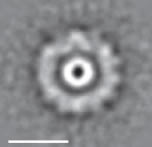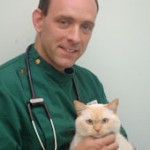Since November 2012 in England seventy six dogs have contracted CRGV aka Alabama Rot – 68 dogs have died (14) from the disease and only eight have survived – a 90% fatality rate (16).
At the New Forest Dog Owners Group (NFDOG) AGM on 22nd October 2014, the vet Fiona Macdonald BVMS MRCVS, from www.fish-treatment.co.uk, spoke about how she was trying to establish whether CRGV* is caused by Aeromonas hydrophila bacteria. (1) Fiona said:
“Aeromonas hydrophila is a disease of a variety of fish species, other aquatic species such as frogs and newts and is an organism found in the environment.” (17)
Fiona said in a personal communication (10) that A. hydrophila bacterial isolation from tissues is virtually impossible:
“A. hydrophila is known to cause ulcerative skin lesions in both ornamental and farmed fish with subsequent kidney failure. In addition, it is a very toxigenic organism and so the kidney failure will be a toxin response, making bacterial isolation from target tissues virtually impossible. It has also been recorded as a significant problem in humans subsequent to major environmental incidents such as tsunamis, as well as being a causal agent in necrotising fasciitis.” (10)
Necrotising fasciitis “flesh eating disease” is caused by a bacteria. It should not be confused with Ebola “flesh eating disease” which is caused by a virus. (12)
Necrotising fasciitis aka “flesh-eating disease” destroys the body’s soft tissue. Necrotising means “causing the death of tissues”. Fascia means “tissue that connects muscle or internal organs such as the kidney.” This disease is caused by A Streptococcus (group A strep), Klebsiella, Clostridium, E. coli, Staphylococcus aureus, and Aeromonas hydrophila, among others. Necrotizing fasciitis symptoms start within hours after an injury. The skin develops ulcers and blisters or black, red or purplish spots. Fever, chills, fatigue (tiredness) or vomiting follow the initial wound or soreness. To control this disease, antibiotics are given. But because the bacterial toxins can destroy soft tissue and reduce blood flow, antibiotics may not reach all of the infected and decaying areas. This is why rapid surgical removal of dead tissue may be critical to stopping the infection. (11)

Fiona Macdonald said:
“There is a suspicion that initial cases of CRGV occurred in areas with substantial amounts of water (as a result of unusually high rainfall) and both the running water and the standing water were at 4°C for some weeks around the time of the cases. There have been recorded cases of Aeromonas hydrophila in dogs which mirrored Leptospira infections (5) and this disease remains on the list of possible causes.” (10)
CRGV may have an environmental origin because it has a seasonal distribution from November to June. Fiona said:
“The cause of CRGV in the UK remains unknown; however, dogs may develop CRGV after an unknown environmental exposure as the disease appears to have a seasonal distribution (cases occur between November and June).” (10)
Fiona compares the drier 2014/2015 winter with the previous wetter two winters:
“I am currently running a long term investigation combining retrospective serum sampling from recovered cases combined with in-contact dogs along with specialised sample taking from the skin lesions on first presentation at the veterinary practices involved. Hopefully we might have some results later in 2015, but the weather this winter has been significantly drier than the last two winters and there seems to have been a parallel reduction in cases to date.”
A letter was published in 2015 in the Veterinary Record by Fiona Macdonald (18).

Aeromonas hydrophila bacteria were responsible for flesh eating disease in a Georgia woman. (4)

Amy Horneman, a microbiologist said:
“when Aeromonas hydrophila comes into contact with humans, it has the potential to wreak havoc. In extremely rare cases it can lead to necrotizing fasciitis – unless its presence is recognized and treated (with Ciprofloxacin, Bactrim, SXT or Septra).” (4)

Aeromonas hydrophila bacteria secrete a toxin Aerolysin (9) which binds to proteins of red blood cells and forms pores in the
cell membrane causing hemolysis. (6-8)
Aeromonas hydrophila caused a fatal disease in a dog – symptoms included kidney necrosis. (5)

Duncan Reavell of Lynwood Veterinary Group has treated several dogs with Alabama Rot in the New Forest. (2) He is interested in Fiona Macdonalds’ hypothesis that Alabama Rot might be caused by dogs walking in streams with fish infected by Aeromonas hydrophila.

“the alabamarot.co.uk map is fantastic (13,14)” Duncan Reavell
References
(1) http://www.woodgreenvillagenews.org.uk/localnewspages/localnews-2011to2020/ongoingnews/mysterydogillness.htm (accessed 28th February 2015)
(2) http://www.bbc.co.uk/news/uk-england-hampshire-21698837 (accessed 28th February 2015)
(3) http://biopublisher.ca/files/upfiles/t1-b(10).png (personal communication with Deborah Campbell on 23rd December 2014) (accessed 28th February 2015)
(4) http://articles.latimes.com/2012/may/15/nation/la-na-nn-flesh-eating-bacteria-20120515 (personal communication with Deborah Campbell on 23rd December 2014) (accessed 28th February 2015)
(5) Andre-Fontaine, G., Monfort, P., Buggin-Daubie, M., Filloneau, C. and Ganiere, J.P. (1995) ‘Fatal disease mimicking leptospirosis in a dog, caused by Aeromonas hydrophila.’, Comp Immunol Microbiol Infect Dis., vol. 18, no. 1, pp. 69-72 [Online]. http://www.ncbi.nlm.nih.gov/pubmed/7889733 (personal communication with Deborah Campbell on 23rd December 2014 & with Fiona Macdonald BVMS MRCVS on 2nd March 2015) (accessed 28th February 2015)
(6) Singh, V., Somvanshi, P., Rathore, G., Kapoor, D. and Mishra, B.N. (2010) ‘Gene Cloning, Expression, and Characterization of Recombinant Aerolysin from Aeromonas hydrophila’, Applied Biochemistry and Biotechnology, vol. 160, no. 7, pp. 1985-1991.
(7) Degiacomi, M.T., Lacovache, I., Pernot, L., Chami, M., Kudryashev, M., Stahlberg, H., van der Goot, F.G. and Dal Peraro, M. (2013) ‘Molecular assembly of the aerolysin pore reveals a swirling membrane-insertion mechanism’, Nature Chemical Biology, vol. 9, no. 10, pp. 623-629.
(8) Parker, M.W., Buckley, J.T., Postma, J.P.M., Tucker, A.D., Leonard, K., Pattus, F. and Tsernoglou, D. (1994) ‘Structure of the Aeromonas Toxin Proaerolysin in its Water-Soluble and Membrane-Channel States’, Nature, vol. 367, no. 6460, pp. 292-295.
(9) https://en.wikipedia.org/wiki/Aerolysin (accessed 1st March 2015)
(10) Personal communication with vet Fiona Macdonald BVMS MRCVS (2nd March 2015)
(11) http://www.cdc.gov/features/necrotizingfasciitis/ (accessed 2nd March 2015)
(12) http://www.dailymail.co.uk/news/article-2587320/New-outbreak-deadly-flesh-eating-Ebola-virus-killed-59-people-Guinea-according-Unicef.html (accessed 2nd March 2015)
(13) Personal communication with vet Duncan Reavell MA VetMB CertSAM MRCVS (24th February 2015)
(14) Alabamarot.co.uk map http://alabamarot.co.uk/alabama-rot-uk-cases-map/ (accessed 2nd March 2014)
(15) https://www.linkedin.com/pub/fiona-macdonald/3b/154/79 (accessed 2nd March 2014)
(16) http://alabamarot.co.uk/who-are-the-experts-in-alabama-rot-david-walker-of-amvs/ (accessed 2nd March 2014)
(17) http://alabamarot.co.uk/could-fatal-alabama-rot-in-dogs-be-caused-by-a-fish-disease/#comment-177 (accessed 19th April 2014)
(18) http://veterinaryrecord.bmj.com/content/176/18/469.1.extract (accessed 26th June 2015)
* Fiona Macdonald and some other professional vets are not keen on the term ‘Alabama Rot’ for the syndrome suffered by dogs in the New Forest and other areas, since they are not convinced it is the same disease since there seem to be a number of differences between what was observed in the US and over here. They prefer the term ‘CRGV’ (cutaneous and renal glomerular vasculopathy). (10)

Interesting article, in humans we tend to see more Aeromonas infections during the warmer months of the year, when you get blooms of aeromonads in warmer water. In addition, some strains of Aeromonas have been shown to carry the Shiga-like toxin (plus many other toxins) that can cause kidney problems. I relation to difficulty in the isolation of bacteria from the leasions. Have you considered a meta-genomic approach using 16S ribosomal DNA sequencing of all bacteria present in the lesions. This should give you a starting point of what is there or not.
Hi Jonathan,
thanks for your comments on using Metagenomics using 16S ribosomal DNA sequencing. The researchers (David Walker, Laura Holm and others) working on CRGV did use this technique: http://alabamarot.co.uk/wp-content/uploads/2015/03/Veterinary-Record-2015-Holm-vr.102892.pdf
(1) Holm, L.P., Hawkins, I., Robin, C., Newton, R.J., Jepson, R., Stanzani, G., McMahon, L.A., Pesavento, P., Carr, T., Cogan, T., Couto, C.G., Cianciolo, R. and Walker, D.J. (2015) ‘Cutaneous and renal glomerular vasculopathy as a cause of acute kidney injury in dogs in the UK’, Veterinary Record, vol. accepted January 21st 2015, no. available free online 23rd March 2015, pp. 1-12.
See http://alabamarot.co.uk/peer-reviewed-crgv-research-by-david-walker-et-al/ for further info.
The Histopathology section said “Renal tissue from two dogs was submitted to two separate laboratories with both laboratories receiving both samples (Department of Medical Microbiology and Immunology, School of Medicine, University of California, Davis, USA; University of Bristol Veterinary Diagnostics, School of Veterinary Sciences, University of Bristol, Langford, Bristol, UK) for evaluation with a broad spectrum set of 16S rRNA-directed probes (to detect bacterial genetic material). From one laboratory, a clear 16S band was identified in the tissue of one dog and a faint band in the other. Staphylococcaceae were identified in both samples. The other laboratory identified solely Leptospires in both samples.”
Chris Street
It would be helpful to know if the affected dogs were walked off-lead, or walked in or near water.
Karen, Thanks for your comment.
I’ve added an extra 2 columns: ‘Walked off lead?’ ; ‘Walked in / near water?’ to the map tables: http://alabamarot.co.uk/alabama-rot-uk-cases-map/
Sorry Chris – been a bit busy and haven’t had time to check your information. Aeromonas hydrophila is a disease of a variety of fish species and is not related to spawning. It can also infect other aquatic species such as frogs and newts, and it is an organism which is found in the environment.
Thanks Fiona, I’ve update the post accordingly.
When are you going to give another talk about the possible cause of CRGV?
Chris Street
As you have said (correctly) in the article the bacterium itself releases toxins. Spawning fish do not release toxins and so the headline is misleading. Aeromonas hydrophila is an environmental organism and does not require the presence of fish. Please correct an otherwise good article.
Fiona, Thanks for your comments. I’ve updated the headline from ‘Is CRGV caused by toxin released by spawning fish infected with Aeromonas hydrophila bacteria?’ to ‘Is CRGV caused by Aeromonas hydrophila bacteria?’.
Is there any other information or references you can suggest?
Chris Street